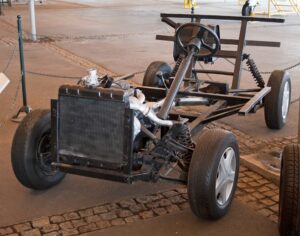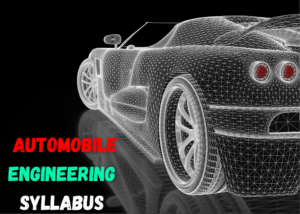Automobile Engineering, Parts, and Syllabus
Automobile engineering, also known as automotive engineering, is a branch of engineering that deals with the design, development, production, and maintenance of automobiles. It encompasses a wide range of technical and scientific disciplines to create vehicles that are safe, efficient, and environmentally friendly.
Automobile engineers work on various aspects of vehicles, including their mechanical systems, electronics, software, and overall design. They strive to improve vehicle performance, fuel efficiency, safety features, and user comfort.
Key areas of focus in automobile engineering include:
1. Vehicle Design: Creating the aesthetic and functional aspects of vehicles, including exterior and interior design, ergonomics, and user experience.
2. Powertrains: Designing and optimizing engines, transmissions, and drivetrain systems for efficient power delivery and better fuel economy.
3. Chassis and Suspension: Developing the framework of the vehicle and its suspension systems to ensure stability, comfort, and safety during driving.
4. Electronics and Control Systems: Integrating electronic components like sensors, actuators, and control units to enhance vehicle performance, efficiency, and safety.
5. Vehicle Dynamics: Analyzing how vehicles behave in different conditions, including factors like handling, steering, braking, and traction control.
6. Safety Systems: Designing safety features such as airbags, anti-lock braking systems (ABS), electronic stability control (ESC), and advanced driver assistance systems (ADAS).
7. Alternative Propulsion: Exploring and implementing alternative propulsion systems like electric and hybrid powertrains to reduce emissions and dependence on fossil fuels.
8. Materials and Manufacturing: Selecting appropriate materials for vehicle components and optimizing manufacturing processes for cost-effectiveness and quality.
9. Emissions Control: Developing technologies to minimize the environmental impact of vehicle emissions, such as catalytic converters and emission control systems.
10. Testing and Validation: Conducting rigorous testing procedures to ensure that vehicles meet safety standards, performance criteria, and regulatory requirements.
Automobile engineering plays a crucial role in shaping the automotive industry and contributing to advancements in transportation technology. It requires a multidisciplinary approach, involving expertise in mechanical engineering, electrical engineering, computer science, materials science, and more. As the automotive landscape evolves with the emergence of electric and autonomous vehicles, automobile engineers continue to push the boundaries of innovation in the field.
Automobile Engineering syllabus:
Semester 1:
1. Introduction to Automobile Engineering
– History and evolution of automobiles
– Types of vehicles and their classifications
– Role of automobile engineers in the industry
2. Basics of Mechanical Engineering
– Mechanics and thermodynamics
– Fluid mechanics and heat transfer
– Materials and manufacturing processes
3. Engine Fundamentals
– Internal combustion engines (IC engines)
– Engine cycles and working principles
– Engine components and systems
Semester 2:
1. Vehicle Dynamics
– Basics of vehicle motion
– Suspension systems and design
– Steering and braking systems
2. Automotive Electronics
– Sensors and actuators in vehicles
– Engine control and electronic fuel injection
– Vehicle communication systems
3. Automotive Materials and Manufacturing
– Material properties and selection
– Welding, casting, and machining processes
– Quality control in manufacturing
Semester 3:
1. Transmission Systems
– Manual and automatic transmissions
– Clutches, gearboxes, and drivelines
– Hybrid and electric powertrains
2. Vehicle Design and Aerodynamics
– Vehicle layout and packaging
– Aerodynamic principles and design considerations
– Crash safety and structural design
Semester 4:
1. Automotive Thermodynamics
– Engine performance and efficiency
– Combustion analysis and emissions control
– Alternative fuels and their impact
2. Automotive Maintenance and Diagnostics
– Routine maintenance procedures
– Troubleshooting and diagnostics techniques
– Condition monitoring and predictive maintenance
Semester 5:
1. Automotive Chassis Systems
– Frame and body design
– Braking and stability control
– Tire design and selection
2. Vehicle Testing and Validation
– Performance testing and benchmarking
– Vehicle safety testing and crash simulations
– Environmental testing and regulatory compliance
Semester 6:
1. Advanced Vehicle Propulsion
– Electric and hybrid vehicle technologies
– Fuel cell and alternative propulsion systems
– Energy storage and management
2. Autonomous and Connected Vehicles
– Sensor technologies and perception systems
– Control algorithms for autonomous driving
– Vehicle-to-vehicle and vehicle-to-infrastructure communication
Semester 7:
1. Automotive Project Management
– Project planning and execution
– Cost estimation and resource allocation
– Risk management and quality control
2. Emerging Trends in Automobile Engineering
– Sustainability and environmental considerations
– Mobility as a Service (MaaS) and future transportation concepts
Semester 8:
1. Internship or Research Project
– Practical industry experience or research project
– Integration of theoretical knowledge into real-world applications
Conclusion
In conclusion, automobile engineering stands as a pivotal discipline within the realm of engineering, focusing on the intricate design, development, and maintenance of vehicles that drive our modern world. It seamlessly blends diverse fields such as mechanical engineering, electronics, materials science, and more, to shape the automotive landscape. From the inception of the first automobiles to the contemporary era of electric and autonomous vehicles, automobile engineers have been the driving force behind innovations that enhance vehicle performance, safety, sustainability, and user experience.
As the automotive industry evolves, automobile engineers play a critical role in meeting the ever-changing demands of society. They create vehicles that not only cater to transportation needs but also contribute to environmental conservation and technological advancement. The pursuit of efficiency, safety, and reduced emissions fuels their endeavors, while the integration of cutting-edge electronics and software ushers in a new era of connected and autonomous mobility.
In essence, automobile engineering is a dynamic and multifaceted discipline that epitomizes human ingenuity and technological progress. With each passing innovation, the world of automobiles takes steps closer to a future where transportation is not only efficient and convenient but also sustainable and intelligent. In the grand tapestry of engineering, automobile engineering remains a driving force that propels us into a future of transformative transportation possibilities.







